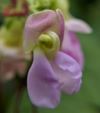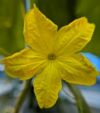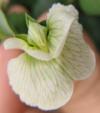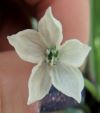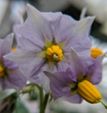eOrganic author:
Hannah Swegarden, Cornell University
Introduction
If you’ve ever thought of developing a new plant cultivar or simply combining the characteristics of two cultivars you love, you may wish to conduct some directed plant breeding of your own. To help get you started, we’ve put together eight introductory pollination guides for common vegetable crops. These photographic guides are intended to provide a brief overview of how to make crosses using controlled pollination techniques. They are available in PDF or PowerPoint format, and are now also available in French, thanks to Hugo Martorell of the Bauta Family Initiative on Canadian Seed Security! Find the French version of this page here.
Download the guides at the links below:
Controlled Pollination
Controlled pollination is useful to plant breeders who would like to generate a hybrid between two different plants or cultivars of the same species. The goal of pollination is to enable fertilization and, ultimately, to generate viable hybrid seed. Pollination can be performed by transferring pollen produced on the same plant (self-pollination) or from a different plant (cross-pollination). To do so, however, we need a basic understanding of floral anatomy and pollination techniques specific to each species.
Floral anatomy and biology vary dramatically from species to species, so take a little extra time to read up on the anatomy and best environmental conditions for successful pollination. Vegetable seed production generally requires the transfer of pollen grains (male gametes) from one flower to the receptive female reproductive organs (stigma, style, and ovary) of another. The success of your pollination can depend on time of day, plant age, temperature, and many other factors. Each of these guides is accompanied by images depicting the reproductive portions of the flowers, but we encourage your own research into the floral structure and biology of each vegetable crop.
These introductory guides were developed with the assumption that controlled pollination occurs in an environment without any external pollinators (e.g., bees, flies, wind, etc.). If you're making crosses outdoors or in an area without proper pollination barriers (e.g., a greenhouse or netted cage), there is a chance of cross-contamination from different pollen sources. Pollen exclusion techniques, specific to the floral biology and species, may be necessary. Select the appropriate pollination bag and corresponding tie, tape, clothespin, etc., to exclude pollinators, maintain appropriate humidity levels, and allow sufficient sunlight if needed. In many cases, it is also advisable to place an exclusion barrier around male flowers prior to opening to avoid contamination from insects. Once fruit has begun forming, exclusion barriers can be removed from female flowers.
Accompanying these guides is a gentle reminder to use appropriate harvest, drying, and storage practices to prevent the spread of seed-borne diseases and reduce the possibility of losing your seed crop. There are a number of additional resources on crop botany and seed-saving techniques, including books such as Breed Your Own Vegetable Varieties (Deppe, 2000), Seed-to-Seed (Ashworth, 2002), and The Organic Seed Grower (Navazio, 2012). There are additional resources on the Organic Seed Alliance (OSA) and eOrganic websites, such as the article Pollination and Fertilization in Organic Seed Production. Use these guides as a starting point to understand the basics of vegetable pollination but know that you may need to adjust these techniques depending on available equipment and environmental constraints. No two plant breeders perform pollinations in the same way—so feel free to explore what methods work best for you! Enjoy!
This project was supported by the NOVIC project, which was funded by the NIFA OREI program and Cornell AgriTech.
References and Citations
- Ashworth, S. 2002. Seed to seed. Chelsea Green Publishing, White River Junction, VT.
- Deppe, C. 2000. Breed your own vegetable varieties. Chelsea Green Publishing, White River Junction, VT.
- eOrganic [Online]. eXtension. eXtension Foundation. Available at: https://eorganic.org/
- Navazio, J. 2012. The organic seed grower. Chelsea Green Publishing, White River Junction, VT.
- Navazio, J., Morton, F., Colley, M., Brewer, L., and Stone, A. 2019. [Online]. Pollination and fertilization in organic seed production. eXtension Foundation, eOrganic Community of Practice. Available at: https://eorganic.org/node/422
- Organic Seed Alliance [Online]. Available at: https://seedalliance.org/
